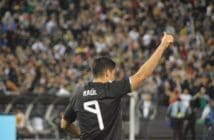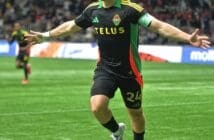Despite having played a 4-3-3 formation for much of his time in charge of the Dutch national team, Frank de Boer looks set to line up with a five-man defence at Euro 2020.
A 4-2 defeat against Turkey in a World Cup qualifier back in March was seemingly the catalyst for a major tactical change. The Netherlands boss was keen to “dominate” games, and started taking training sessions with his squad that focused on playing a five-man defence.
Sure enough, De Boer came out in his pre-match press conference before the friendly clash against Scotland and confirmed that he would be playing a 5-3-2 formation against Steve Clarke’s side and the subsequent clash against Georgia three days later. This was perhaps influenced by the country’s 2014 World Cup campaign, where they secured a third place finish playing with a five-man defence throughout the tournament.
A 2-2 draw against Scotland in Portugal was followed by a 3-0 win against Georgia, but fans and pundits alike mercilessly slated De Boer’s selection decisions and tactical approach. Nonetheless, it looks likely that the former Crystal Palace and Inter Milan boss will stick with his new formation for the Netherlands’ Euro 2020 campaign.
So how should Holland line up if they do keep their controversial 5-3-2 formation?
Goalkeeper: Tim Krul
The goalkeeper situation is far from ideal for the Oranje. First-choice keeper Jasper Cillessen missed out on a place in the squad after testing positive for Covid, which resulted in the 32-year-old doing a interview with Dutch newspaper De Telegraaf where he attacked De Boer for making false promises regarding his selection.
Norwich’s Tim Krul, Ajax’s Maarten Stekelenburg and AZ’s Marco Bizot were the three goalkeepers called up to the squad. Bizot was the only one not to play in the Netherlands’ two recent friendly games, with Krul and Stekelenburg lining up against Scotland and Georgia respectively.
Despite becoming first choice for de Godenzonen in recent months, it seems likely that Stekelenburg would probably be better dropping to the bench due to Krul’s good form at Carrow Road and his impressive knack of saving penalties.
Left wing-back: Owen Wijndal
In this system, there’s only one real choice for left wing-back – AZ’s Owen Wijndal.
Patrick van Aanholt offers a similar skillset, but his underwhelming campaign with Crystal Palace means that he will likely be kept out of the starting lineup. Daley Blind is another alternative, although doesn’t suit the wing-back role and would be much better suited elsewhere in the team.
Wijndal’s excellent performances have seen him linked with a possible move to FC Barcelona. While he plays left-back in a 4-3-3 formation for AZ, the 21-year-old’s attacking qualities are clear to be seen, having registered six assists in the Eredivisie last season. In an Oranje shirt, he’s registered the second most crosses in the entire squad since his debut, which is an area that the team clearly need to improve upon based on recent performances.
Left centre-back: Daley Blind
Centre-back is the strongest position in this Netherlands side, which is probably why De Boer has opted to play three of them.
As stated by his manager, Blind has experience of playing in a five-man defence, having been part of the squad for the 2014 World Cup that adopted the same tactical approach. The 31-year-old gravitates to the left side, often playing left-back in a flat back-four. Nicolas Tagliafico’s form for Ajax has seen Blind move to centre-back, however, and that will likely be where he starts against Ukraine on Sunday.
Centre-back: Stefan de Vrij
De Vrij comes into this tournament on the back of winning Serie A with Inter, and will clearly be a crucial player in a strong defensive lineup for the Netherlands. The 29-year-old is one of the few players who will suit De Boer’s 5-3-2 formation, having played in the middle of a five-man defence for the Nerazurri last season.
He’ll likely be given the same role for his national team and tasked with playing as the middle of the three centre-backs, as he has done recently against Scotland and Georgia.
Right centre-back: Mathijs de Ligt
Of course, De Ligt is always going to be one of the first names on the team sheet. He’ll likely be tasked with filling the void left by injured captain Virgil van Dijk, as the 21-year-old is a similarly physical and aggressive presence in the heart of defence.
While directly replacing the Liverpool defender is a task too big for even a player of De Ligt’s standard, the Juventus youngster could be one of the stars of the tournament. However, a recent knock in training has left his position in the team in doubt, with the player himself stating that he has a “60% chance” of being fit to face Ukraine as things stand.
If he does miss out, 19-year-old Ajax defender Jurriën Timber would be most likely to take his place, with Brighton’s Joel Veltman another option available to De Boer.
Right wing-back: Denzel Dumfries
Holland’s options on the right side of defence leave a lot to be desired. Hans Hateboer appears as the obvious answer to play at right wing-back, but his poor international form and recent injury has seen him left out of the squad. Joel Veltman has regularly played in the same position at club level, but doesn’t offer the required level of attacking output. This leaves PSV’s Dumfries as the main option.
The 25-year-old isn’t a bad player by any means, but his defensive positioning and awareness was exploited in the draw against Scotland. He improved against Georgia, but never looked to be a standout player while on the pitch. Playing in a 4-4-2 formation with his club won’t help, given that De Boer’s system offers him no protection down the flank. Nonetheless, he is probably the best choice for the role.
Spartak Moscow’s Quincy Promes has occasionally been used as a right-wing back and could be an option, but the possible reemergence of an ongoing legal battle could limit his contribution at the tournament.
Left centre-midfield: Frenkie de Jong
Keeping the three-man midfield in this Dutch lineup is crucial, and Barcelona’s De Jong is arguably the cog that keeps it ticking. The Ajax academy graduate was incredible for De Godenzonen, especially in their spectacular Champions League run in 2018/19. His move to Catalonia has seen him become one of Barça’s key players in what has been a disastrous couple of years for the club.
De Jong is capable of playing on either side of midfield, having dropped to the left side of a double pivot for Ajax while playing on the right side of a 5-3-2 for Barcelona to accommodate Pedri. Having moved to the left in recent friendlies for the Netherlands, it looks like that will be his starting position for their games in Euro 2020.
Centre-midfield: Georginio Wijnaldum
Being in the midst of an ongoing transfer saga isn’t ideal ahead of a major tournament, but it seems that Wijnaldum will take the captain’s armband from former Liverpool teammate Van Dijk for Euro 2020. With his move to PSG now confirmed, the 30-year-old can fully focus on performing for his national team.
Much like De Jong, Wijnaldum offers immense versatility across the midfield three, although he will likely be tasked with playing through the middle. He hasn’t played in this position too often for Liverpool, and when he has, he’s struggled with the defensive responsibility required in this role.
However, having three centre-backs behind him rather than the two he did at Anfield will likely give him the confidence and freedom to play centrally rather than the shifted to either side.
Right centre-midfield: Davy Klaassen
Before we start, let’s make one thing clear – De Roon should not be in consideration to start in this position. The Atalanta midfielder has been abysmal in a Netherlands shirt in recent games, and his horrendous record of giving the ball away doesn’t warrant a starting spot at Euro 2020. Nonetheless, De Boer has moved to defend the 30-year-old, indicating that he could line up against Ukraine on Sunday.
13.5 – Marten de Roon lost possession 13.5 times per 90 minutes in international games under Frank de Boer, the highest average of all midfielders in this period. Sloppy. https://t.co/Nebd7ihOYE
— OptaJohan (@OptaJohan) June 10, 2021
A midfield trio of De Jong, Wijnaldum and De Roon offers little in terms of creative intent. Donny van de Beek would be a suitable replacement despite hardly having played any football for the last 12 months, but the Manchester United midfielder was forced to drop out of the squad following a groin injury.
As a result, a more attack-minded midfielder is needed, and Ajax’s Klaassen seems to fit the bill after another solid season in Amsterdam where he recorded 12 goals and three assists in the Eredivisie. The 28-year-old does prefer to play centrally where possible, so his club teammate Ryan Gravenberch could be given the nod to start following his first Oranje goal against Georgia.
Left striker: Memphis Depay
There’s no debate that Depay will be starting up-front for the Netherlands in Euro 2020.
The Lyon attacker is the country’s talisman, and as it stands, their only real outlet for goals. A natural left-winger, Depay has moved into a central position for his club, where he’s registered an astonishing 20 goals and 12 assists in 37 Ligue 1 matches last season. As a result, a move to Barcelona is on the cards for the out-of-contract Dutchman.
In such a defensive system, there’s going to be a definite over-reliance on the 27-year-old. He’ll likely be on set pieces too, having scored a free-kick against Scotland and a penalty against Georgia. He comes into the tournament in good form, but if that subsides, Holland’s chances of progressing out of the group could be in real danger.
Right striker: Donyell Malen
There’s no arguing that Wout Weghorst is an incredibly talented player. He works unbelievably hard and has been in impressive form for Wolfsburg, scoring 20 Bundesliga goals last season. On top of that, he scored his first international goal in the win against Georgia which will undoubtedly lift his morale ahead of Euro 2020. But he shouldn’t be in the starting lineup.
De Boer seems keen to play with a target-man striker, such as Weghorst, but then doesn’t instruct his wing-backs to get forward and deliver crosses into the box. As a result, it leaves them short in attack and puts even more pressure on Depay. There is an incredible lack of width in a 5-3-2 formation, and the Netherlands have to pick players that will thrive in that system if they’re going to succeed.
Enter Donyell Malen. The PSV striker came on in the second half against Georgia, partnering Depay up top, and the pair looked incredibly threatening for the entire time they were on the pitch together. While he failed to score in the friendly game in Enschede, the 22-year-old reached an impressive 19-goal tally in the Eredivisie last season, proving that he has a real clinical edge to combine with his searing pace.
Playing in a strike partnership at club level will help him thrive in De Boer’s 5-3-2 formation. Ultimately, that’s what the Netherlands boss has to do – find players who suit the system that he wants to play.
Full starting lineup:
T. Krul, O. Wijndal, D. Blind, S. De Vrij, M. De Ligt, D. Dumfries; F. De Jong, G. Wijnaldum, D. Klaassen; M. Depay, D. Malen
Follow us on Twitter @ProstInt
![Prost International [PINT]](https://prostinternational.com/wp-content/uploads/2021/08/PINTtFontLogoRoboto1536x78.jpg)


